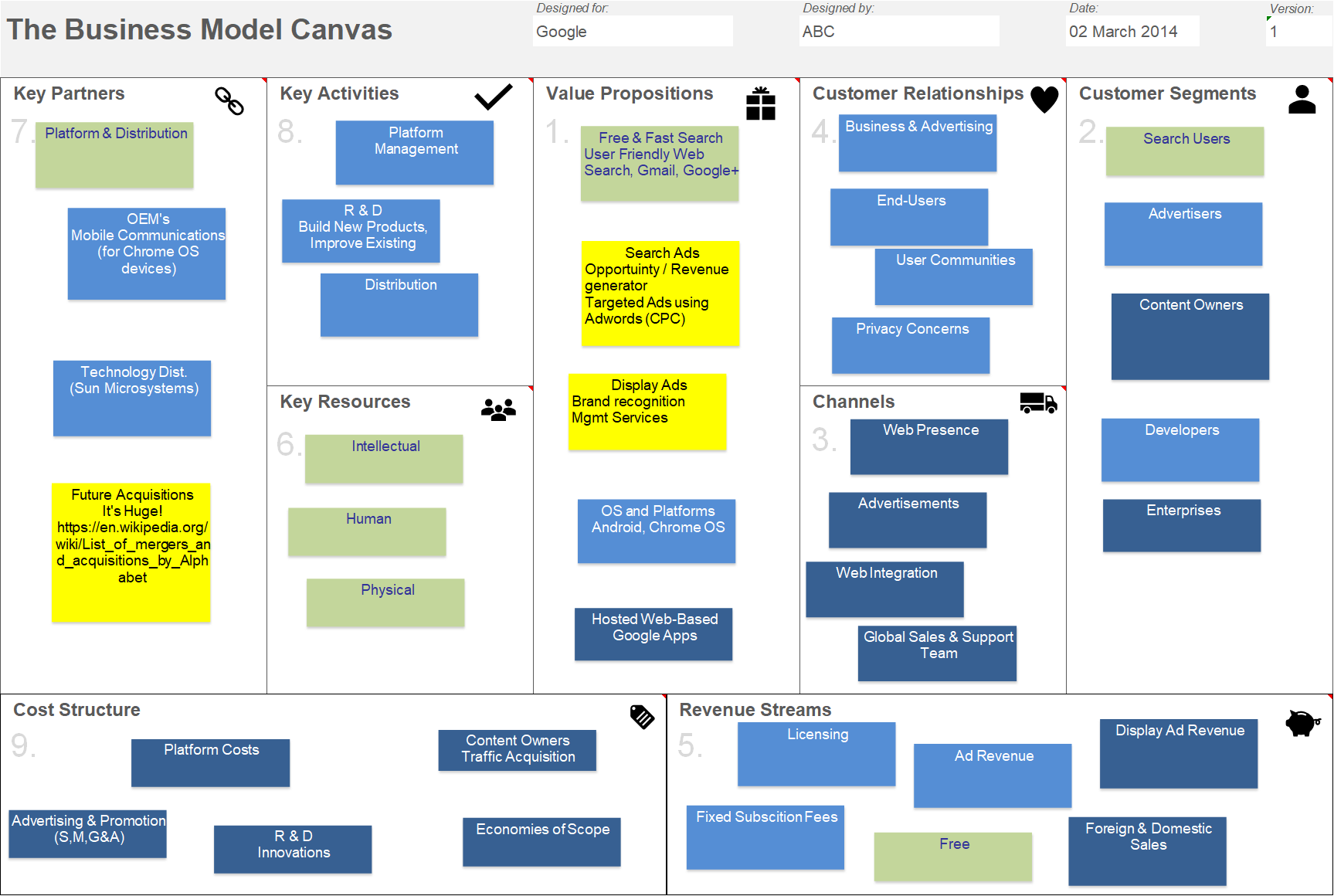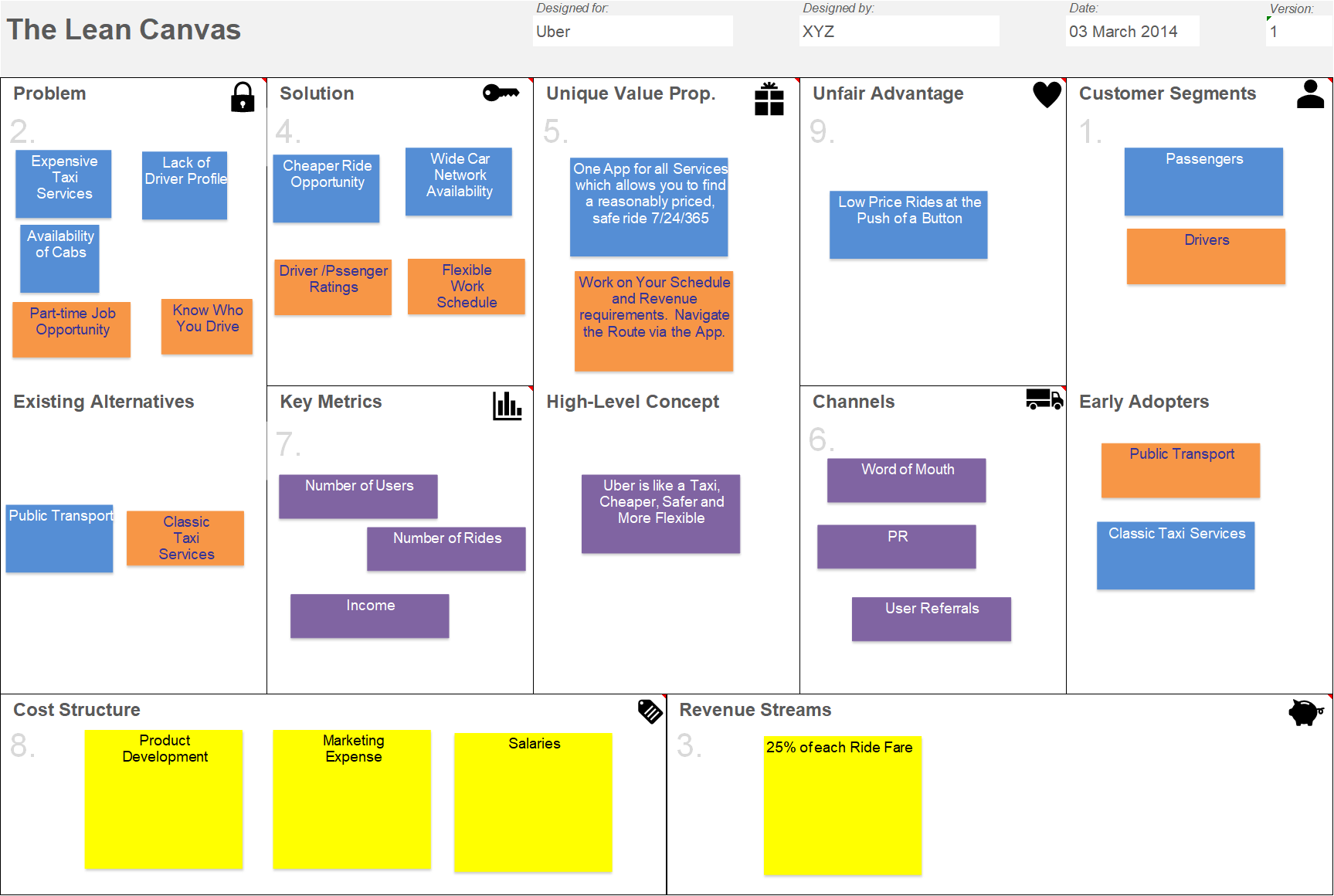RECAP
Here’s an example of the Business Model Canvas for Google. (click to enlarge)
Free Templates available at the end of this post.
KEY TAKEAWAYS
- Highly visual tool that gets you and your team focused on the 9 essentials (complete in order).
- It’s for established businesses and gets reviewed and refined quarterly. Yes, things change!
- The key is 1 and 2. While we think we know our Value Proposition and Customer Segments, we often fall short.
- Spend the most time on the Value Proposition Canvas (below).
LEAN CANVAS
The real value for start-ups is 3 components:
- Business Model Design
- Customer Development
- Agile Engineering
These three components help startups become incredibly efficient reducing the amount of time to get the first product and reducing the amount of cash necessary to build that product. The key is going to be learning and discovering from prospective customers outside your office. By getting out of the building and testing some of your key ideas and key features of the product as quickly and as rapidly as we can and what you’re going to find is a good number of your initial hypotheses are just simply wrong.
There are no facts in your building…
This is about start-ups. Here’s an example of the Lean Canvas for Uber. (click to enlarge)
Free Templates available at the end of this post.
KEY TAKEAWAYS
- Highly visual tool that gets you and your team focused on the 9 essentials (complete in order).
- Don’t assume. Spend lot’s of time with prospective customers.
- Allows startup founders to mitigate the risk and uncertainty associated with a product inception.
- When our hypotheses turn out to be incorrect you get to change those hypotheses and those are called pivots. A pivot is defined as a substantive change to one or more of the business model canvas components if it’s a minor change we call it an iteration.
- Spend the most time on the Value Proposition Canvas (below).
If you use your $$$ to create exceptional products and services, you can spend less $$$ on advertising…
VALUE PROPOSITION CANVAS
The Value Proposition Canvas is divided into two parts, the customer profile circle and the value map square. Each part consists of three sections that describe specific features of a customer or product respectively the circle on the right refers to the customer segment and describes the motivation to buy the product and consists of jobs/roles to be done, gains and pains explains why the customer needs this product. The square on the left features the value map by listing products and services as well as describing pain relievers and gain creators.
This is for start-ups and existing businesses. Here’s an example of the Value Proposition Canvas for Uber. (click to enlarge)
Free Templates available at the end of this post.
KEY TAKEAWAYS
- One Canvas per customer segment.
- Jobs and Roles are deep. There can be several such as: Functional Jobs, Social Jobs, Emotional Jobs, Supporting Jobs and in complex B2B sales there can be many factors: such as a Company Role – what are their work responsibilities corporate and positional; Performance Role – what do they need to perform at their personal best; Identity Role – what keeps them motivated at work and outside.
- Pains and Gains should be measured and rated in terms of Intensity.
- In a given environment the customer “is who he/she is“. Your job is not to change them, rather influence them by developing products and services that solve their problems.
More than a half of new products/services fail to meet customers’ expectations and fade away…
KEY TAKEAWAYS FOR ALBERTA BASED BUSINESS
It’s tough out there! We’ve been through this so many times. Yet as Albertans we’ve always had a steadfast resiliency. We are always focused on re-positioning, re-purposing our business models. We have to! Enclosed please find a Excel file that has the 3 Canvas’s and examples. I’m sure you’ll find them useful. If there’s anything I can help with drop me a line. jamesburrows@shaw.ca
All the best!
Bus-Model-Sine-Cera-Consulting.xlsx (226 downloads )



